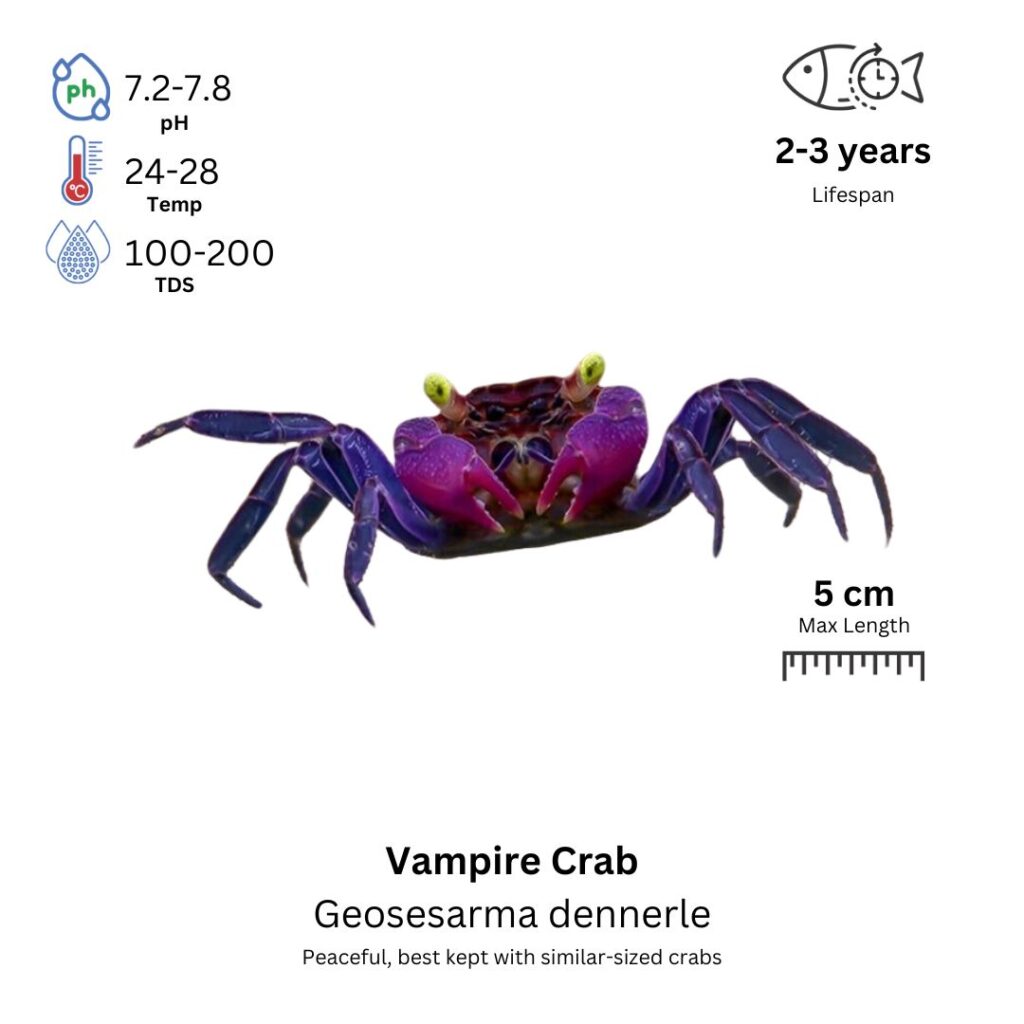Vampire Crab
Geosesarma sp.

Description
The Vampire Crab is a small, colorful species known for its striking appearance, with a vibrant, dark purple or red body and distinctive black markings on its claws, which give it a “vampire” look. These crabs have a compact, rounded body, with sharp, pointed pincers that they use to defend themselves and gather food. Their vibrant coloration, combined with their active and somewhat territorial nature, makes them a popular choice for freshwater aquarium enthusiasts. Despite their intimidating name and appearance, Vampire Crabs are relatively peaceful toward tankmates but can display territorial behavior, particularly when defending their hiding spots. They are primarily nocturnal, becoming more active during the evening and night.
Habitat Origin
Native to the tropical regions of Southeast Asia, specifically from islands like Java and Sumatra, Indonesia. They are typically found in coastal areas near streams and forests, where they live in moist, sheltered environments such as burrows, crevices, and under rocks.
Aquarium
Ideal Number in Aquarium: 1 – 2 individuals for small tanks; larger groups can be kept in larger aquariums with adequate hiding spots.
Favorite Food

Vampire Crabs are omnivores and will accept a variety of foods. They typically feed on algae, detritus, small insects, and plant matter. In captivity, they can be fed a mix of high-quality crab pellets, sinking carnivore pellets, freeze-dried worms, vegetables (such as spinach and zucchini), and occasionally live or frozen foods like brine shrimp. It’s essential to provide a varied diet to ensure their health and vibrant coloration.
Behavior:
Vampire Crabs are active and territorial, spending a lot of time hiding and exploring their environment. During the night, they become more active, often climbing on decorations, plants, and substrate to search for food. Although they are generally peaceful toward tankmates, they can become territorial, especially when they have access to hiding spots. They are relatively small and will often retreat into burrows or crevices during the day to rest. They tend to stay near the bottom of the tank but may occasionally climb on the rocks or decorations.
Special Care:
Vampire Crabs require a tank with both terrestrial and aquatic areas, as they are semi-aquatic. It’s important to provide a land area with a moist environment (like damp soil or coconut husk) where they can hide and burrow. The aquatic area should be shallow, as they are not strong swimmers and should have access to water to hydrate themselves, but the water should not be too deep. It’s essential to maintain a high humidity level in the tank to replicate their natural environment. Regular water changes and a clean, well-filtered tank will help keep them healthy.
Compatibility with Other Fish:
Vampire Crabs are generally best kept with other peaceful, non-aggressive species. They may be compatible with small fish or peaceful invertebrates that do not encroach on their territory or invade their hiding spots. However, they should not be kept with larger fish that may view them as food or aggressive species that could bully them. It’s important to house them with tankmates that will not disturb their resting places or compete aggressively for space.
Breeding Setup
A separate breeding tank is recommended for Vampire Crabs to maintain ideal environmental conditions and prevent predation on eggs. A 10-gallon tank (38 liters) is suitable for a small group, while a 20-gallon tank (75 liters) is better for multiple pairs. Maintain pH 6.5–7.5, temperature 24–28°C (75–82°F), and hardness 6–12 dGH. High humidity is essential. Use fine gravel or sand and moisture-retaining substrates with plenty of hiding spots like driftwood, rocks, and live plants (e.g., Java moss or Anubias). Install a gentle sponge filter and provide moderate lighting on a 12-hour cycle.
Conditioning for Breeding
To condition Vampire Crabs for breeding, offer a nutritious, protein- and calcium-rich diet. Feed them live or frozen foods like brine shrimp, daphnia, and bloodworms, along with vegetables like blanched spinach and zucchini. Supplement with cuttlebone or crushed eggshells for exoskeleton health. Perform 20–30% weekly water changes and maintain high humidity (above 70%) to replicate their tropical environment, essential for reproductive behavior.
Spawning Process
Spawning occurs when conditions are ideal—warm temperature, high humidity, and stable water. Males court females by waving their claws and performing display dances. After mating, females carry 50–100 eggs under their abdomen for 2–3 weeks until they hatch. It’s not always necessary to separate the parents, but if male aggression is observed post-spawning, consider relocating one of the adults to avoid harm.
Fry Care
Eggs hatch in 2–3 weeks, and the larvae are aquatic at first. Keep humidity and temperature stable to support development. Initially, fry feed on infusoria, biofilm, and micro-organisms. Once they reach the juvenile stage, introduce microworms, crushed pellets, and baby brine shrimp. Perform small, frequent water changes (10–20%) every 1–2 days, and maintain humidity above 70% to ensure healthy molting and growth.
Important Notes
Vampire Crabs are ready to breed at 6–12 months. Males are more active and have larger claws, while females are rounder, especially when gravid. Avoid sudden shifts in pH, temperature, or humidity, as stress can halt breeding. Maintain excellent water quality, avoid overcrowding, and provide a calm, structured habitat for breeding success. Regular observation and careful maintenance are key to raising a healthy generation.
